Although peaches can certainly be grown outdoors in milder or more sheltered areas of the UK, their success is really reliant on the season. Get a mild year and peaches can crop very well, but in a cold, wet season you can expect very small crops.
The closely related nectarines with their smooth skins are even less reliable and ideally require the protection of a greenhouse, polytunnel or conservatory to do well.
Nonetheless as with several other fruits which are ‘borderline’ in our climate, not because of hardiness of the tree, but frost when the flowers are open, a good year can make several bad ones worthwhile.
Peach Varieties
Some varieties are better suited to our climate than others. The most famous varieties of peach, and the most reliable, are ‘Peregrine’ and ‘Rochester’. These can be grown in the open in warm or sheltered areas, but are more reliable when grown as fans against a warm wall.
Nectarines are suitable only for very favoured areas, try ‘Early Rivers’ and ‘Lord Napier’. These are the ones most often seen in catalogues.

Peach Growing Tips
Choose a site which is both sheltered and sunny on free-draining soil and which holds plenty of moisture during the summer. Improve dry soils by digging in well rotted organic matter such as garden compost or manure prior to planting. This treatment should also be given to the soil before planting in the conservatory border.
If growing as a fan, buy a tree which is three years old and already partly trained. Before planting fix some strong wires to the wall with vine eyes at 45cm (18in) intervals to support the framework of branches as they grow.
As with cherries and plums, pruning should not be done in the winter, but in late spring or early summer once the sap rises as this helps to avoid problems with bacterial canker and silver leaf.
Bushes are trained in much the same way as plum trees but for fans cut back any branches growing away from the wall or into it, then thin the sideshoots on each branch by pinching off every other one.
In May cut back the growth from the remaining sideshoots to five or six leaves. Finally, after fruiting cut back to the lowest shoot on each side branch, removing all but the lowest shoot. This is the replacement shoot – the one on which fruit will develop next season.
The fruits may require thinning in stages during the summer if the crop is heavy until 20cm (8in) apart. This ensures that the fruit which eventually matures is of a good size and quality.
Give your tree a dressing of Growmore or pelleted chicken manure in the spring before mulching with well-rotted garden compost. In pots add a new layer of fresh compost to the top of the pot and feed every 14 days, as the fruit is developing, with a high potash tomato food.
Scrumptious recipes for your homegrown peaches
More grow guides
For more growing tips and guides, you should subscribe to Kitchen Garden – you’ll receive free seeds with every single issue too!











